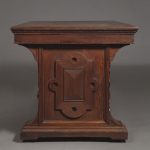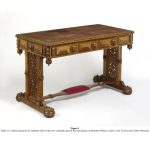11606 AN INTERESTING AND UNUSUAL OAK LIBRARY TABLE IN THE ANTIQUARIAN STYLE Probably English. Second Half Of The Nineteenth Century. Measurements: Width: 60″ (152.4 cm); Depth: 32″ (81.3 cm); Height: 30″ (76.2 cm).

Research
Of oak. The rectangular oak top with molded edge rests upon a finely carved foliate undermold and plain frieze with carved bead and reel lower edge. The two substantial rectangular standard paneled ends to the base are centered by prominent Neo-Tudor geometric applied raised motifs. From the side issue plain corbels with fretted Neo-Tudor applied ornament. The whole raised on stepped plinths united by a plain broad incurved stretcher with molded edge. Minor repairs to small carved losses to be carried out.
The present table is a particularly interesting and austere rendering of a style known in England as Antiquarianism and in central Europe as ‘Historicism.’
In England it was largely an aristocratic or connoisseurial style and examples can be witnessed in iconic houses such as that of the collector William Beckford, at Lansdown Crescent and Tower, as well as at Mamhead. The architect most associated with the style was Anthony Salvin (1799–1881) who not only designed Mamhead but also designed the principle furniture at that same house (figure 1).
Sir Walter Scott also included furniture of this type for his great house Abbotsford and it is true to say that the taste was initially particular to Britain; it was sparked by a rediscovery and celebration of Britain’s exalted past, especially decorative arts and architecture of the Tudor era.
This example is a highly notable for its deliberate understatement employing limited Neo-Tudor embellishments combined with the plain massive end supports giving the table a surprisingly modern aesthetic.






Comments are closed.